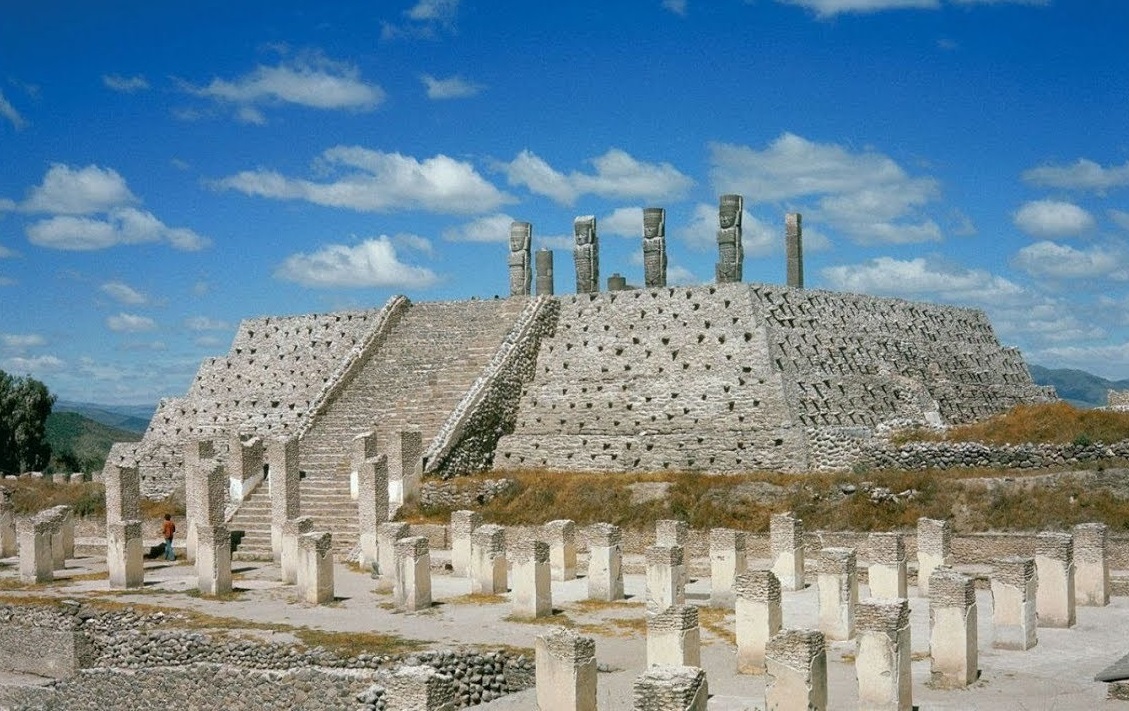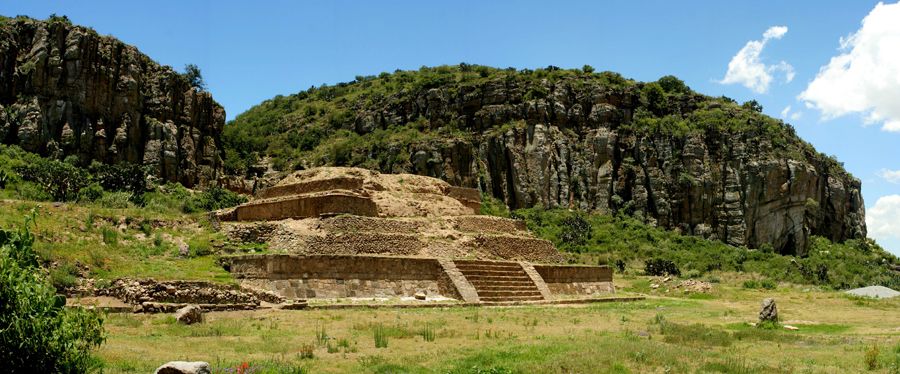The Toltecs were one of the Mesoamerican civilizations that managed to evolve architecture in their time, which was intended primarily for religious and ceremonial purposes, so much was their good work in the construction of Toltec Ceremonial Centers, that these served as inspiration to other civilizations.

Characteristics and functions of the ceremonial centers of the Toltecs
The Toltecs were recognized for their great contribution to architecture in ancient times, this led to them being called master builders. The construction of pyramids and Toltec ceremonial centers, were worked in great detail that were and continue to be a symbol of unique beauty, in the development of these they added their mythological and religious conceptions.
The Toltec ceremonial centers were spaces where worship, respect, and veneration was offered to the gods. These were found in the middle of the cities of this civilization, and were usually identified by their enormous square-shaped spaces, raised on a rock platform with perfect incisions, in addition to having some stairs that were used to reach the top of these . They also had large covered areas, supported by wooden beams and rock columns.
The columns were usually carved in the forms of feathered warriors or vipers, as well as gruesome scenes of humans and skulls. Surrounding this type of construction there were other works also made of stones, which was where the high-level society lived, such as the leaders, priests and officials of this society.
The rest of the houses that were in the city and that represented the low-level society such as peasants, artisans and merchants, were made with materials of less resistance to time such as brick and mud.
In contemporary times, there have been some historians who have insinuated that the Toltec civilization is mythical, that this was simply a utopia of the Aztecs to claim the name of descendants of expert builders. However, the Nahuatl traditions emphasize that the Toltecs were the forerunners of civilization and that they generated a great projection in art, architecture, and culture.
Important Ceremonial Centers of the Toltecs
Established primarily as a Toltec ceremonial center. It is important to note that despite the fact that some of the temples mentioned here are related to other neighboring cultures, the architecture of the ceremonial centers shows a very marked influence of the Toltec culture. Next, we will detail which were the most significant and magnificent works created by this civilization, these are:
Tlahuizcalpantecuhtli Temple
In the vicinity of Mexico City, 80 km from remote Tenochtitlán, we find Tula, which in approximately 700 AD was the most flourishing metropolis of the Toltecs and the Mesoamerican region; it is estimated that more than 85.000 inhabitants lived there. The original name of Tula, this remote Toltec metropolis was Tollan Xicocotitlan, which in Nahuatl means "place of the tul (a large tree) or reeds".
It is located in the southern state of Hidalgo and was built on a small mountain, which facilitates its protection against the conquerors. The Toltecs who lived there were mostly soldiers, but it was also inhabited by many peasants.
Tula was an economically important metropolis, known for controlling the turquoise and obsidian trade, its importance was so great that its culture spread to Yucatan, it reached El Salvador and even Nicaragua. Tula's heyday was due to the fall of Teotihuacán, as many people migrated to nearby places.
The history of the decline of this city is not very clear, but it is believed that it was due to religious reasons. The believers of the god Quetzalcoatl continuously argued with the followers of the god Tezcatlipoca, who won over and banished the disciples of Quetzalcoatl from the city.
Currently, the city of Tula is a national park where ancient buildings are protected and what most attracts the attention of visitors are its ceremonial centers, such as:
The Tlahuizcalpantecuhtli temple was founded around the 1100s, it is a proportionate and totally decorated work. The 43-meter-high stair temple ends in an altar; the detail of this temple shows the anxiety of this culture for astronomical events.
The walls of its 5 sunrooms are sculpted with numerous friezes depicting a furious gang of ocelots, coyotes and eagles that gobble up human hearts, and allegories of the planet Venus associated with the goddess of love in Greek culture, Venus is shown here as Tlahuizcalpantecuhtli , the God of dawn a god of strong character.
The 9-meter-high temple encloses a long room covered in wooden beams and resting on stone pilasters symbolizing Toltec warriors, while the temple's luminaries are ordered with Venus.
Huacapalco
The entire territory of Huapalcalco is appreciated as one of the most transcendental spaces of the pre-Hispanic civilization, since the original Toltecs settled in this part. In this area located on the western slope of Cerro del Tecolote, which is incorporated with 2 architectural ensembles. In addition to being mesmerized by the temples and other ancient discoveries, the region has many cave paintings dating back around 13 years.
It was the seat of the Second Toltec Empire, before its migration to Tula; In this place, the three-part ceremonial center stands out with the characteristics of Teotihuacan, its base measures 12 meters and its height is 8 meters. Likewise, there is an altar where it is believed that it served as a deposit for offerings, the set of cave paintings that have considerable antiquity as already mentioned, makes this place one of the first areas to be populated in the American continent.
Temple of the Warriors – Chichen Itza
The temple of the warriors of Chichen Itza was built around the year 1200 and is one of the most beautiful and excellently maintained works in this place. In particular, its construction presents qualities similar to those of the Tlahuizcalpantecuhtli temple in Tula, the transcendental metropolis of the Toltecs; especially, for its foundation practically the new Mayan-Toltec civilization that was produced here in Chichen Itza.
From the characteristics in relation to the architecture of the other Toltec temples, we can determine the following similarities:
- The overall concept of the temple, which supports a huge upper sanctuary.
- There is the same representation of a Chac Mool at the entrance.
- It is a similar type of ornamentation, as for the eagles and ocelot at the base of the stairs.
- It has pillars in the shape of a snake, with its head on the ground and its mouth open, while its body forms the axis and its tail rises to support the lintel of the entrance.
- At the foot of the temple, you come across the same type of columns with engravings of warriors.
The temple of the warriors had been prefixed as El Castillo, due to an original work that was found inside the existing temple. The original temple also had a Chac Mool inside and the arched forms used by the Mayans.
This building consists of a platform with a square structure that measures approximately 40 meters on each side. It has stepped bodies that consist of a slope and a cornice adorned with bas-reliefs in which we see warriors, eagles and ocelots gobbling up human hearts.
The staircase faces west and features reliefs of plumed serpents whose heads protrude. There is a square-shaped temple with a base of 21 m on each side, leaving a wide platform in front with pilasters decorated with figures of gods and warriors who raised beams on the ceiling.
The front of the temple is combined by an inclined wall and a vertical one, like a discontinuous plinth for the first access, and ornamented at each point by a panel with three superimposed Chac masks, 1 with the image of the god Kukulkan emerging from the mouth of a plumed serpent with forked tongue, and 3 other Chac masks in the corner, one on top of the other and with curved and prominent noses. Then another smooth plinth between two molded cornices, ending with battlements on the roof, of which nothing remains.
On the platform and in front of the main entrance there is a Chac Mool, long ago it was seen as a god that functioned as a mediator between the Supreme God and humanity, in order to take the gifts that they made.
Tzompantli
This was an altar where the bloody heads of murdered captives were impaled in front of the public to glorify their deities. It is a distribution emanating from the custom among Mesoamericans of decapitating the victims of human oblations and keeping their skulls in a kind of wooden fence. This type of altars can be seen in different parts of Mexico such as Chichen Itza, Tula and in the Templo Mayor located in the Center of Mexico City.
If you found this article about the Toltec Ceremonial Centers interesting, we invite you to enjoy these other articles:


